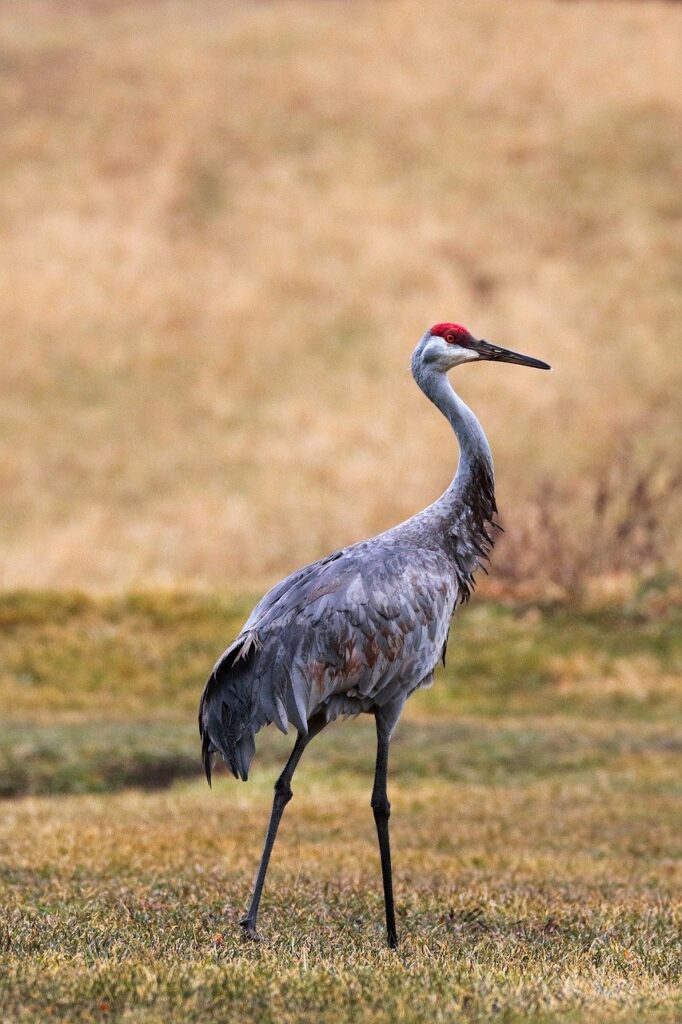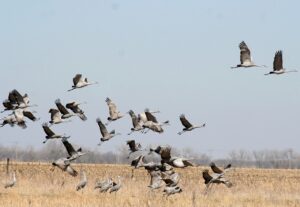 A month ago, Carrie and I drove to a neighboring state to witness a natural occurrence of global renown. Every spring, a particular bird species descends in droves upon a small stretch of the Platte River in America’s midwest as they migrate north. Tour tickets in hand, we drove most of the day to get to our AirBnB in Nebraska’s Great Plains. After a quick dinner, we navigated to the Rowe Bird Sanctuary, a remote enclave down a dusty, washboarded dirt road. Our volunteer guide enthusiastically described how we were about to observe one of only a handful of mass migrations still viewable on the planet.
A month ago, Carrie and I drove to a neighboring state to witness a natural occurrence of global renown. Every spring, a particular bird species descends in droves upon a small stretch of the Platte River in America’s midwest as they migrate north. Tour tickets in hand, we drove most of the day to get to our AirBnB in Nebraska’s Great Plains. After a quick dinner, we navigated to the Rowe Bird Sanctuary, a remote enclave down a dusty, washboarded dirt road. Our volunteer guide enthusiastically described how we were about to observe one of only a handful of mass migrations still viewable on the planet.
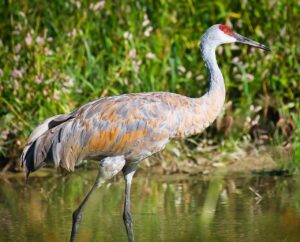 The sandhill crane, an elegantly tall bird, stands four feet high with a long neck and beak. With gray feathers and black legs, the bird’s most remarkable coloring comes from the bright red crown adorning the top of its head and eyes. As many as 80% of their worldwide population spend a few weeks in Nebraska, gorging on leftover corn to provide necessary energy and fat to complete their journey. The previously harvested fields they forage during the day offer plentiful waste grain, which would otherwise sprout up as volunteer plants. (By some estimates the cranes consume as much as 1600 tons of fallen corn during their midwestern vacation!) They mate for life, and their next task is to build nests and raise young. Most fly on to the Arctic circle, with as many as a fifth nesting in northeastern Siberia.
The sandhill crane, an elegantly tall bird, stands four feet high with a long neck and beak. With gray feathers and black legs, the bird’s most remarkable coloring comes from the bright red crown adorning the top of its head and eyes. As many as 80% of their worldwide population spend a few weeks in Nebraska, gorging on leftover corn to provide necessary energy and fat to complete their journey. The previously harvested fields they forage during the day offer plentiful waste grain, which would otherwise sprout up as volunteer plants. (By some estimates the cranes consume as much as 1600 tons of fallen corn during their midwestern vacation!) They mate for life, and their next task is to build nests and raise young. Most fly on to the Arctic circle, with as many as a fifth nesting in northeastern Siberia.
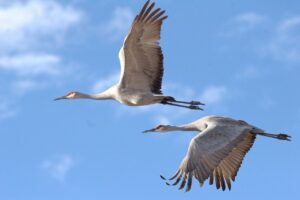 After our orientation, the guide instructed us to walk silently the half mile to our blind where we’d spend the next two hours. Soon we saw clusters of birds circling in the distance. This “staging” lasts about an hour before they come in to roost for the night. Three deer on the far shore tentatively made their way across the shallow river before the cacophony began. Did I mention this was not a quiet event? With almost a half million cranes in residence that week, the air reverberated with the beat of their wings and their raucous calls, a sound some describe as a trilling “r.” Boasting an impressive five-to-seven-foot wingspan, the cranes circled in groups, some descending scarcely a hundred feet away. More and more arrived, until there were thousands massed on the river’s sand bars.
After our orientation, the guide instructed us to walk silently the half mile to our blind where we’d spend the next two hours. Soon we saw clusters of birds circling in the distance. This “staging” lasts about an hour before they come in to roost for the night. Three deer on the far shore tentatively made their way across the shallow river before the cacophony began. Did I mention this was not a quiet event? With almost a half million cranes in residence that week, the air reverberated with the beat of their wings and their raucous calls, a sound some describe as a trilling “r.” Boasting an impressive five-to-seven-foot wingspan, the cranes circled in groups, some descending scarcely a hundred feet away. More and more arrived, until there were thousands massed on the river’s sand bars.
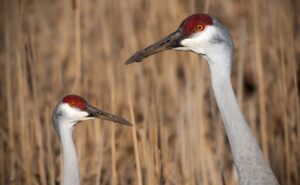 Visitors have described this as a spiritual experience and speak of their awe at the sight and sounds. I find it remarkable that so many marvel at the creation yet fail to consider its Creator. As Romans 1:20 testifies, Since the creation of the world His invisible attributes, His eternal power and divine nature, have been clearly seen, being understood through what has been made, so that they are without excuse.
Visitors have described this as a spiritual experience and speak of their awe at the sight and sounds. I find it remarkable that so many marvel at the creation yet fail to consider its Creator. As Romans 1:20 testifies, Since the creation of the world His invisible attributes, His eternal power and divine nature, have been clearly seen, being understood through what has been made, so that they are without excuse.
Take time to acknowledge God’s handiwork. You don’t have to witness a bird migration to recognize the whole earth is full of His glory! (Isaiah 6:3). As you go through the seasons this year, cultivate your sense of wonder at the world around you. Thank God for a beautiful sunset, savor the smell of pine needles or a flower! And rest in the knowledge that the One who cares for all creation is taking care of you.

